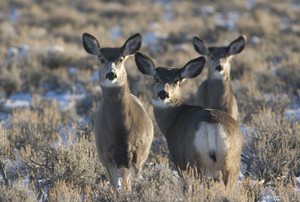University of Wyoming Study Shows High Mule Deer Diversity
Written by Andrew-Rossi on May 25, 2021
It appears Wyoming mule deer populations are simultaneously more restricted and diverse than biologists believed – and it’s all in their genes.
A University of Wyoming-led study determined the state’s mule deer are more diverse than previously believed. After studying deer genetics and behaviors, scientists determined northern, southern, and western Wyoming have their own district populations.
The study, according to UW, “highlights environmental variables that promote and inhibit mule deer gene flow, providing crucial information for land-use planning and conservation efforts. The work also expands understanding of genetic aspects of functional connectivity for mule deer.”
“We identified features of the environment, such as elevation, habitat types, and highways, that promote or inhibit the movement of mule deer genes across the state,” says Melanie LaCava, a UW Ph.D. candidate in the Program in Ecology and Department of Veterinary Sciences. “The environmental variables we found to be important were different at the scale of the entire state compared to each of the three genetic groups, which demonstrates the importance of studying wildlife in geographic areas of different sizes and comparing areas with different habitats.”
Once again, Wyoming hunters proved invaluable in collecting essential research information.
Wyoming Game and Fish provided lymph node samples from 406 harvested mule deer from the fall hunting seasons from 2014 to 2016 for the study. Hunters largely collected those samples during those seasons.
The study found natural and artificial Wyoming landmarks direct affect the genetics of mule deer. Populations are either more similar or different based on where they are located and what impedes their travels.
In all, ten environmental variables in Wyoming’s landscape impact the genomic analysis of mule deer populations.
- Elevation
- Slope
- Topographic roughness
- Land cover
- Proportions of sagebrush, forest, and grassland
- Rivers
- Highways and interstate highways
- Oil and gas wells
Mule deer genetic diversity was directly affected by the features in each section of the state.
For example, genetic diversity was higher amongst northern Wyoming mule deer, especially if populations were separated by highways or oil fields. Meanwhile, western Wyoming mule deer are more likely to migrate throughout the year.
Forests create higher genetic diversity amongst mule deer. Highways, however, drives genetic deer diversity down.
Ironically, this isn’t true for the state’s pronghorn populations. A 2020 study showed pronghorn do not have much genetic variation across the state despite the same natural and artificial features that seem to restrict mule deer.
This information will assist several Wyoming and national entities with mule deer management, preventing isolation, and preserving this high level of diversity.
It will also assist with infrastructure placement and understanding the spread of disease, particularly chronic wasting disease.
The study provides information useful to the Wyoming Game and Fish Department, federal land and resource agencies, including the U.S. Bureau of Land Management, National Park Service, U.S. Forest Service, and U.S. Fish and Wildlife Service, nongovernmental organizations, and private landowners.


